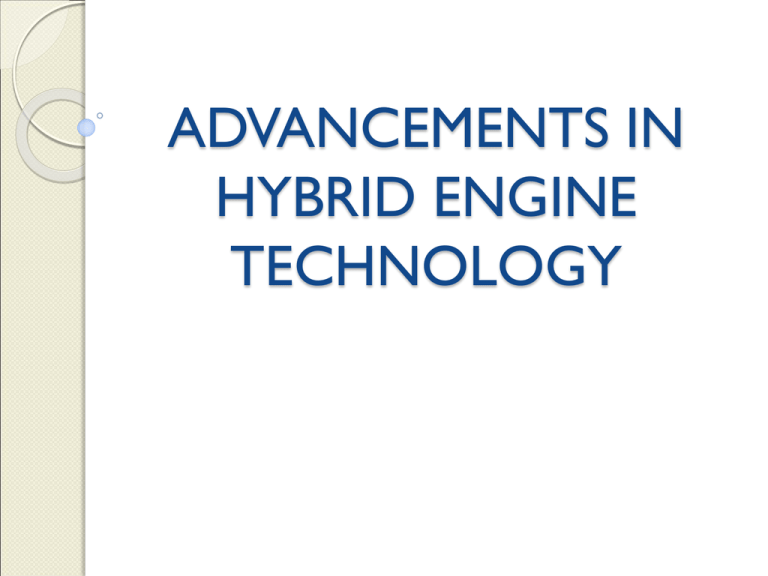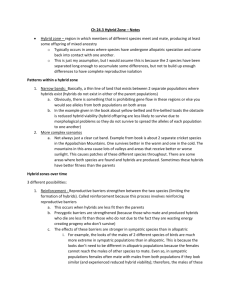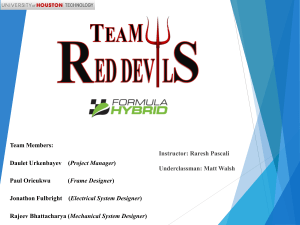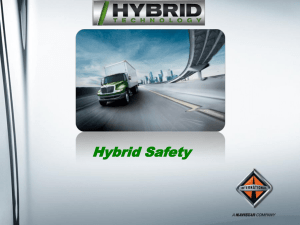click to save-Hybrid Engine
advertisement

ADVANCEMENTS IN HYBRID ENGINE TECHNOLOGY Introduction Definition Need for hybrid engines Brief History Definition Hybrid Engines are typically described as engines with two power sources. A hybrid electric vehicle (HEV) is a type of hybrid vehicle and electric vehicle which combines a conventional internal combustion engine (ICE) propulsion system with an electric propulsion system. Need for hybrid engines: Greener Earth Global warming Sustainable development Increasing price of fuel Electric Motor Lots of torque Zero emissions Tax breaks No transmission needed Starts more efficiently ◦ Can turn off motor when you stop Gasoline Higher energy density than batteries ◦ 1,000 pounds of batteries = 1 gallon (7 pounds) of gas Cheaper initial cost for car ◦ Hybrids are $3500-5000 more Reliable, more history Brief History: 1900 - Ferdinand Porsche developed a gasoline-electric hybrid 1997 – Toyota Prius 1999 – Honda Insight 2000 – Hybrids become core market Advancements in hybrid powertrains Hybrid electric vehicles can be classified according to the way in which power is supplied to the drivetrain: PARALLEL HYBRIDS: In parallel hybrids, the ICE and the electric motor are both connected to the mechanical transmission and can simultaneously transmit power to drive the wheels. Usually parallel hybrids can use a smaller battery pack as they rely more on regenerative braking and the internal combustion engine can also act a generator for supplemental recharging. Parallel hybrids are more efficient for highway driving than in urban stop-and-go conditions. SERIES HYBRIDS: In series hybrids, only the electric motor drives the drivetrain, and the ICE works as a generator to power the electric motor or to recharge the batteries. The battery pack can recharged from regenerative braking or from the ICE. Series hybrids usually have a smaller combustion engine but a larger battery pack as compared to parallel hybrids, which makes them more expensive than parallels. This configuration makes series hybrids more efficient in city driving. SERIES – PARALLEL HYBRIDS: Series-parallel hybrids have the flexibility to operate in either series or parallel mode. They are more efficient overall, because they can operate as a series hybrid at lower speeds and as parallel at high speeds, but their cost is higher than a pure parallel. Degrees of hybridization: FULL HYBRID: Full hybrid, sometimes also called a strong hybrid, is a vehicle that can run on just the engine, just the batteries, or a combination of both. A large, high-capacity battery pack is needed for battery-only operation. MILD HYBRID: Mild hybrid, is a vehicle that can not be driven solely on its electric motor, because the electric motor does not have enough power to propel the vehicle on its own. Mild hybrids only include some of the features found in hybrid technology, and usually achieve limited fuel consumption savings, up to 15 percent in urban driving and 8 to 10 percent overall cycle. A mild hybrid is essentially a conventional vehicle with oversize starter motor, allowing the engine to be turned off whenever the car is coasting, braking, or stopped, yet restart quickly and cleanly. Accessories can continue to run on electrical power while the gasoline engine is off, and as in other hybrid designs, the motor is used for regenerative braking to recapture energy. As compared to full hybrids, mild hybrids have smaller batteries and a smaller, weaker motor/generator, which allows manufacturers to reduce cost and weight. POWER ASSIST HYBRIDS: Power assist hybrids use the ICE for primary power, with a torque-boosting electric motor also connected to a largely conventional powertrain. The electric motor, mounted between the engine and transmission, is essentially a very large starter motor, which operates not only when the engine needs to be turned over, but also when the driver "steps on the gas" and requires extra power. PLUG-IN HYBRIDS: A plug-in hybrid electric vehicle (PHEV), also known as a plug-in hybrid, is a hybrid electric vehicle with rechargeable batteries that can be restored to full charge by connecting a plug to an external electric powersource. A PHEV shares the characteristics of both a conventional hybrid electric vehicle, having an electric motor and an internal combustion engine; and of an all-electric vehicle, also having a plug to connect to the electrical grid. What we can expect in the near future QUERIES











